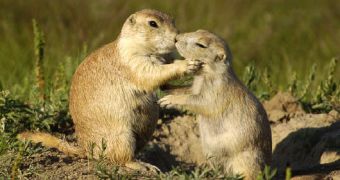1. Despite their name, prairie dogs are related to the ...squirrels! But unlike the squirrels, they have very short Tails and spend most of their life underground. Their name suggests a resemblance between their calls and a dog's bark...
There are 5 species of prairie dogs included in the genus Cynomys: Gunnison' prairie dog (C. gunnisoni) from New Mexico-Arizona-Utah-Colorado, white-tailed prairie dog (C. leucurus) from eastern Utah and southern Montana, black tailed prairie dog (C. ludovicianus) from Canada-US border to US-Mexico border, Mexican prairie dog (C. mexicanus) from northern Mexico (southern Coahuila and northern San Luis Potosi) and Utah prairie dog (C. parvidens) from southern Utah. They are just 30-40 cm (1-1.3 ft) long, 1.5-3 lbs (0.7-1.3 kg) heavy and if they do not move, due to their color, they cannot be observed.
2. Prairie dogs live in large underground colonies or "towns", gatherings of prairie dog families, that can harbor hundreds of individuals. Prairie dogs are extremely sociable, forming strong bounds. They spend a great part of their time to play and caring each other.
The underground galleries can be 5 m (15 ft) deep and over 30 m (100 ft) long, being real labyrinths. The families' burrow entrance is located at 5-6 m (18-20 ft) one from the other. At the entrance orifice in each family's den, there is a soil mound for observation and against floodings.
The towns can cover hundreds of acres. A 19th century Black-tailed prairie dog town in Texas covered 64,000 km? (25,000 sq mi) and was inhabited by 400,000,000 individuals! Now, large towns cannot be seen due to man-made habitat destruction.
3. A family is made up of 2 males and up to 5 females with their offspring (4 each year). The male is extremely territorial, defending his territory by aggression. Prairie dogs reach sexual maturity when being 3 years old.
4. Their galleries are essential as shelter for many creatures like prairie rattlesnake, black footed ferret (both species prey on prairie dogs), mountain plover and burrowing owl. Prairie dogs can be aggressive against predators like badgers and snakes.
5. They form the basis of alimentation for many prairie predators, like swift foxes, bobcat, badger, coyote, weasels, wolverines, black footed ferret and birds of prey (golden eagle and the ferruginous hawk).
6. When two prairie dogs meet, they touch each other's incisive teeth and noses, like in a kiss. Due to their social behavior, prairie dogs can make lovely pets.
7. The "barks" have the role of communicating the presence of a danger and their intensity and tone signal the predator menacing the dogs. There is always an individual over a mound watching over predators.
8.The prairie dogs eat mainly grass, competing this way with the cattle and they rarely drink water. They also eat insects and can be considered cannibals. Their voracity attracted their calling of "pasture rats" and many cattle ranchers consider them a pest, endangering cattle with their burrows, and the animals were poisoned with stricnin or shot.
But many researches show they act like soil fertilizers and their tunnel systems channel rainwater into the water table, impeding runoff and erosion. Prairie dogs also change the composition of the soil in an area by reversing soil compaction produced by cattle grazing. Both the Indians and the colonists appreciated its meat, considered sweet and delicious.
9.Five billions of black-tailed prairie dogs inhabited once vast stretches of the North American prairies. But their faith was similar to that of the bisons and their population has remained reduced by 98 %, remaining concentrated in small areas like South Dakota, Wyoming and Utah.
10. Prairie dogs are susceptible to monkey pox, bubonic plague, tularemia, which they can transmit to humans.

 14 DAY TRIAL //
14 DAY TRIAL //